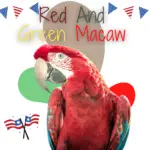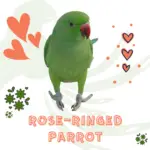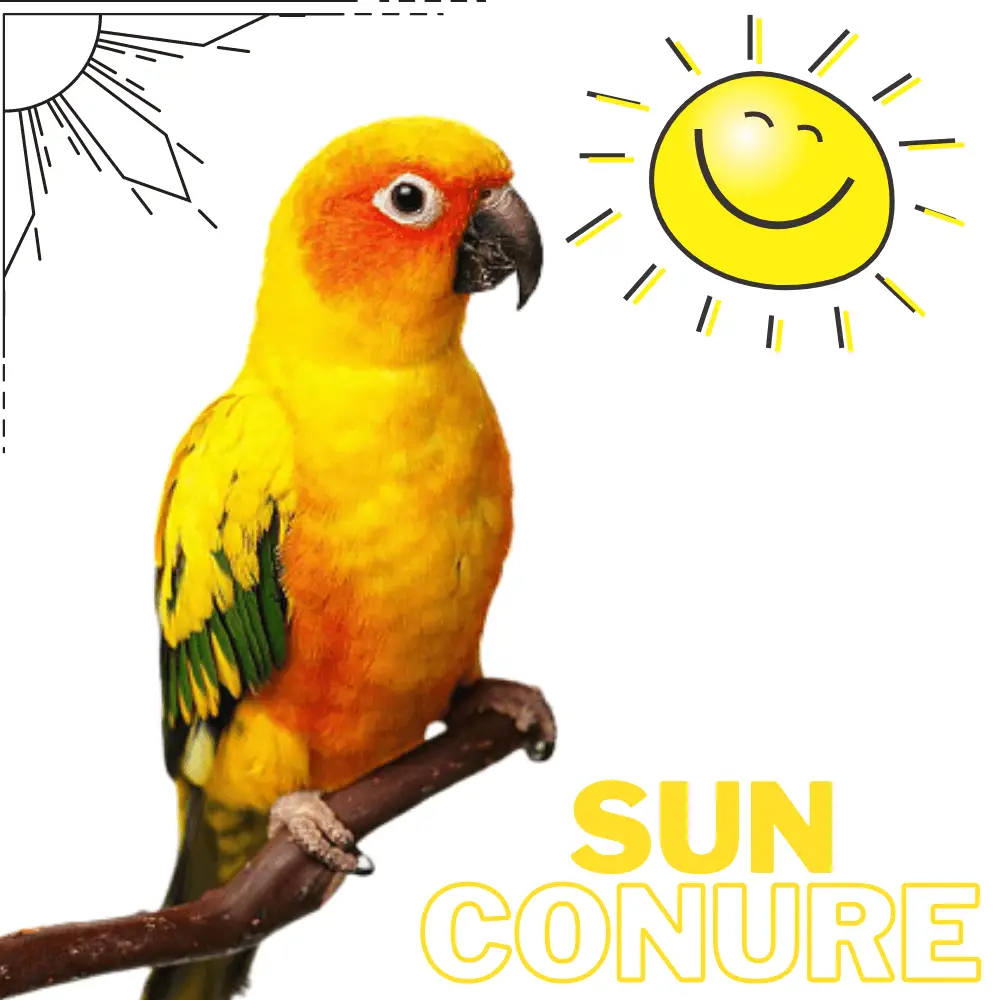
The Sun Conure (Aratinga solstitialis) is a species of conure bird in the Psittacidae family. It has golden yellow plumage.
Although its plumage is predominantly yellow, the sun conure also sports other colors: orange shade on the face and belly, green primary and secondary covers, as well as the remiges at the blue ends.
The irises are brown, the eye circles, the beak and the legs black. It may have reddish plumage which is rare and is more expensive at the market. The sun conure screams and can say a few words according to its interest in speech.
Size
This species measures about 30 cm.
Young
The young have a greenish-yellow coloration with clear orange marks on the face and belly.
Habitat
The sun conure populates the very open secondary forests, the wooded savannahs and the palm groves.
Power supply
Like other conures, this bird consumes fruits, nuts and seeds but it also ingests flowers.
Reproduction
The Sun Conure nests both in pairs and colonies. In the latter case, reproduction is cooperative, with adults feeding their own young but also those of other pairs when they have left the nests.
The female lays between 3 and 6 eggs. Incubation lasts 27 days. It is provided by the female. The young fly away around the age of 8 weeks. After leaving the nest, the parents continue to feed them, the young enjoy spending the night in their original nest box.
Distribution
This parrot is found in South America northwest of Brazil, and also Guyana and southeast of Venezuela.
Captivity
Parrot sun conure, by its very attractive color, is the species of the genus Aratinga most common in captivity. Until 1971, it was still unknown in Europe, but since then it has been bred and reproduced successfully.
In captivity there are two mutations, the most common is the red factor sun conure and the rarest is the yellow mutation (variegated) sun conure. The sun conure “yellow mutation” has an entirely yellow plumage with a shade of orange in the figure and belly. Its beak is shaded with white and its legs are white.
Order: Psittaciformes Famille: Psittacidae
CITES Appendix II, freeholding not subject to quotas
Sex: No sexual dimorphism
Phenotype:
- dark green parrot with yellow-orange breast and head, blue feathers and caudals and dorsal sides of green wings.
- It can be confused with the jandaya conure (A jandaya)
Character: Sun conure Bird able to pronounce a few words and imitator of noises (average capacities) the conures bird are extremely noisy despite their small size, which can quickly exceed the owners
Weight: 110 – 130g
- Can Sun conures talk?
- Is a sun conure a parrot?
- What do Sun Conure parrots eat?
- Do conures talk?
Sun conure Parrot
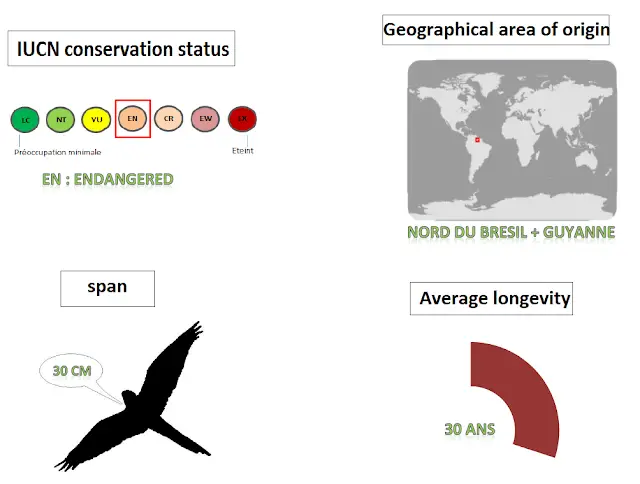
Parrot Sun Conure has been one of the most popular pet bird species for many years. There are many reasons for this, not just that they are probably the most colorful and beautiful Sun Conure species.
While most people are initially attracted by Sun Conures for their beautiful looks, those who fall in love with this species appreciate it because of its many endearing characteristics.
Take a look at the facts listed below to learn more about Sun Conures and what it’s like to keep them as pets.
Sun Conure Price
Purchasing your sun conure parrot from a pet store or breeder can be significantly more precious than one from a original sanctum (a sun conure bird will probably bring between $ 200 and $ 800), but you get the advantage of buying a youngish raspberry, and in some cases, evidence of a health guarantee.
Purchasing your sun conure from a pet store or breeder can be significantly more expensive than one from a local shelter (a sun conure will likely cost between $200 and $800), but you get the advantage of buying a younger bird, and in some cases, proof of a health guarantee.
Sun conure baby
SOURCE:Chris Biro
Sun Conure Lifespan
How long do sun conures live:Adopting a Sun Conure is not a small commitment – with proper care, these birds can have a lifespan of up to 30 years in captivity. Before you start and bring a Sun Conure back home, make sure you are ready and able to commit to taking care of your bird for at least this time.
Too often, unprepared people adopt these types of birds and then decide that they are unwilling to care for them as long as they live, resulting in many homeless parrots. Do not let your bird become a statistic!

Sun Conures size
Arriving about 12 inches in length from the beak to the tail feathers, the Sun Conure parrot is a medium-sized bird with a well-proportioned silhouette, healthy birds being neither thin nor profiled.
They have a classic parrot that looks like them without the size and volume of larger birds like macaws or cockatoos, which makes them very attractive to those who are attracted by the look of more exotic bird species but who do not have room to sleep and take care of it. a very big bird.
Sun conure noise level
Sun Conures are very noisy:Potential owners of Sun Conure bird should understand that these birds are extremely noisy and are not a good choice for those living in apartments. They have a scream that they will emit throughout the day, especially at sunrise and sunset.
Their contact can span miles and help them find each other in the wild while looking for food during the day. In captivity, however, this level of noise can cause problems for those living near their neighbors.
Sun conure talk
Some Sun Conures can learn to speak:Although this is certainly not the case for all Sun Conures, some birds have learned to speak with great success and have managed to accumulate a vocabulary of a few dozen words. In general, however, it is unreasonable to expect Sun Conure to develop the talking prowess of other types of parrots, such as Amazons and Macaws.
More often than not, Sun Conures tend to prefer to imitate other types of sounds, such as whistles, microwaves, doorbells, and phones. Some Sun Conures never imitate any sound and prefer to stick to the normal vocal range of their species.
Continue to 5 of 5 below.
Can green cheek conures talk – Speech and vocalization
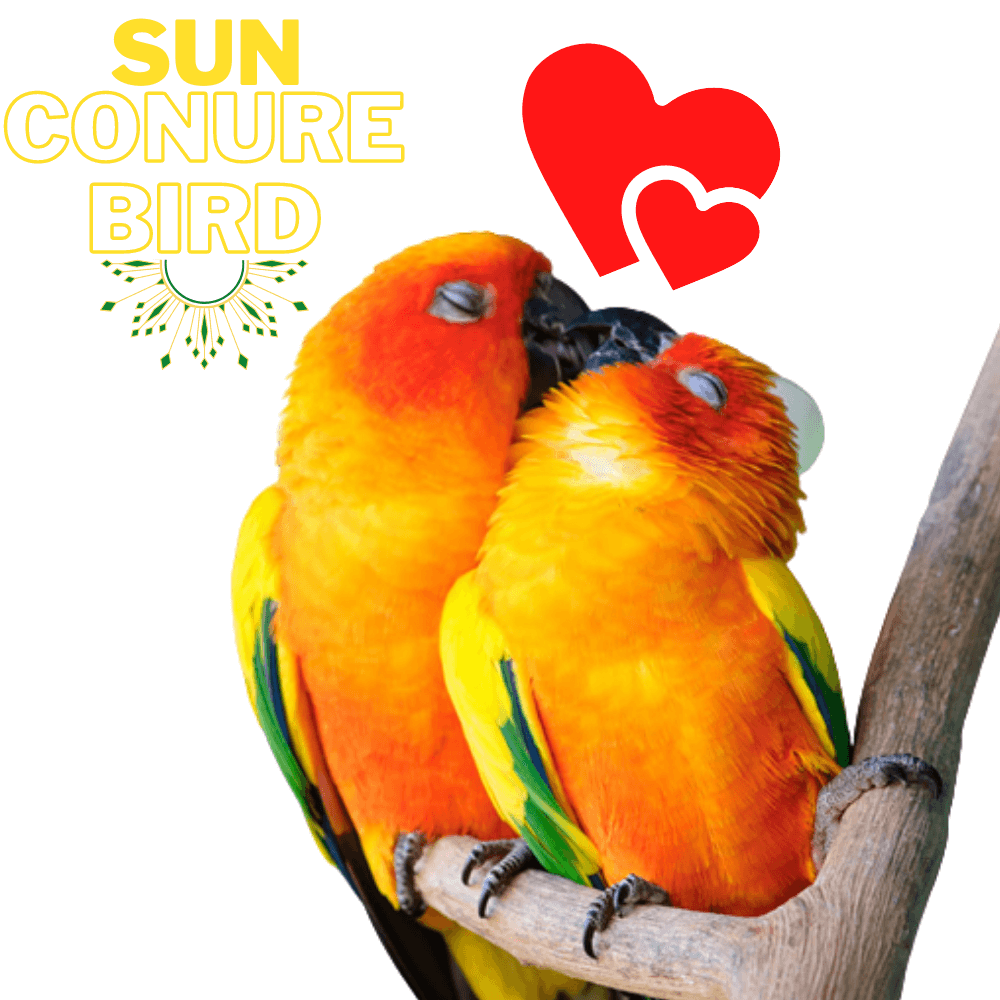
Sun conure colors
Although their colors are somewhat similar to those of the very popular Jure Conure when they are young, the Sun Conures are widely considered the most colorful of all species of Conure. Indeed, a mature Sun Conure has a sporty plumage in a variety of shades of red, yellow, orange green, blue and, in some birds, purple.
Another special feature of the Sun Conure is the white and bare skin around the eyes, called “dark circles”. These patches are similar to bare patches commonly noted in Araw species and are considered by many to be an attractive feature for a parrot.
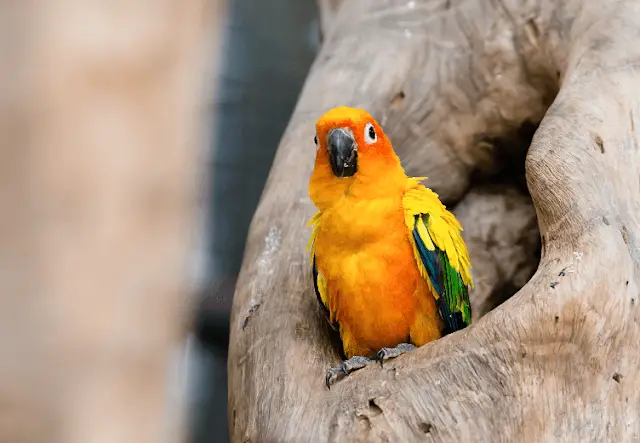
cuddled, caressed, dabbled in all directions. Their vibrant colors have made them very popular around the world, and their adorable character makes them exceptional companion birds.
Sun conure behavior
The Sun conures have a very big personality in a small body. The curiosity of these little parrots is permanent. They seem to want to explore every possible corner of their environment, their cage, the room in which they live, and the sleeve of your sweater too, in which they will not hesitate to sneak.
Origin: South America
Size: 20 to 25 cm
Legal status: Annex 2 Cites
Birds sun conures You will see how attentive they are to everything that happens around them. Besides, at the slightest noise or suspicious intrusion, they will stop all activity to observe what is happening.
They are real clowns who can spend hours playing, climbing on their toys, hanging themselves by the roof of the cage, or munching on a piece of perch.
No way, however, to leave them alone all day, they like contact too much and have a real need for affection. Games, interactions of all kinds, papouilles are therefore essential for their well-being.
They are balls of affection but can have character. It is, therefore, necessary to know how to show firmness sometimes and not to be overwhelmed.
Be careful, their voice in the wild is strident, and the alarm call is quite loud! They basically use it when something or someone bothers them. Fortunately, hand-reared Sun Conures are less stressed and therefore quieter in this respect.
Overall, these little parrots are very friendly to everyone in the family, and even if they choose a favorite human, there is a good chance that they are not too exclusive.
conure soleil2 These are balls of affection but can have character. It is, therefore, necessary to know how to show firmness sometimes and not to be overwhelmed.
Be careful, their voice in the wild is strident, and the alarm call is quite loud! They basically use it when something or someone bothers them. Fortunately, hand-reared Sun Conures are less stressed and therefore quieter in this respect.
Overall, these little parrots are very friendly to everyone in the family, and even if they choose a favorite human, there is a good chance that they are not too exclusive.
Chewing on wood is an essential activity for these active birds. Toys and any other object (cardboard, not too hardwood, etc.) are essential. Don’t forget the shower, they love it!
CONURE CARE
SOURCE:BirdTricks
ABILITY TO TALK sun conures
Generally speaking, Sun Conures are not known to be very good speakers. Some individuals seem to be able to develop a fairly broad vocabulary, but rather expect a few words, or short phrases, expressed in a high pitched voice.
Can Sun Conures Talk
SOURCE:Loc’d Gardening Bird Lady
REQUIREMENTS
These small parrots are very rustic, robust and easy to keep. Give them a proportionately large cage, they are very active and very exploring birds.
Another peculiarity, these birds sleep every night in their nest and it is useful to install a small tent in their cage. In terms of food, no special requirements, these birds eat everything, a mixture of seeds, granules, fruits, and vegetables.
THE IDEAL FAMILY
conures soleil6 Soleil conures will thrive in a fairly calm family, aware of their potential. They are real little parrots with an assertive personality.
Do not hesitate to include them in all your activities, their mini size is not a problem, and take advantage of these exceptional gems, both surprisingly beautiful and intelligent …

